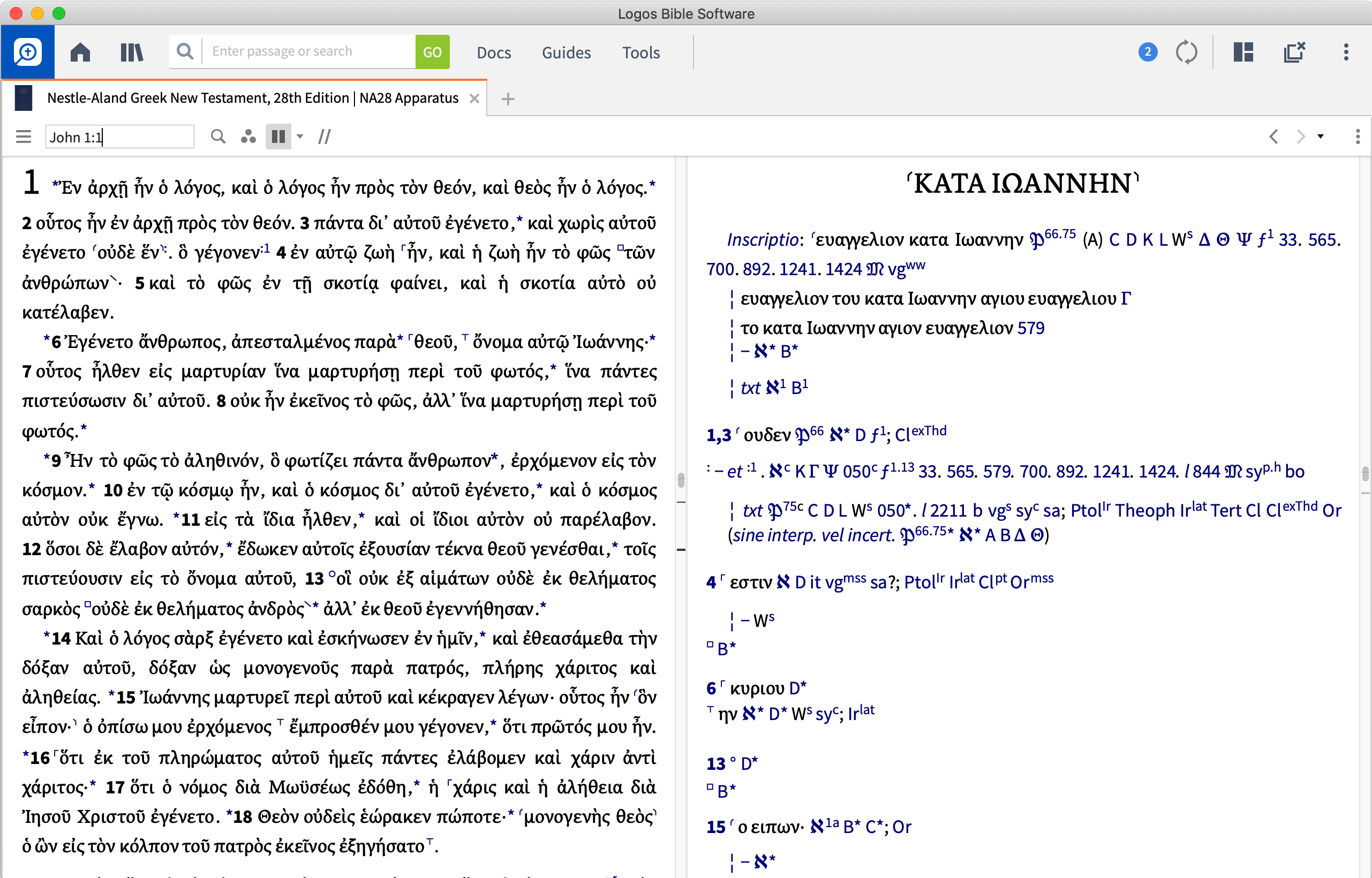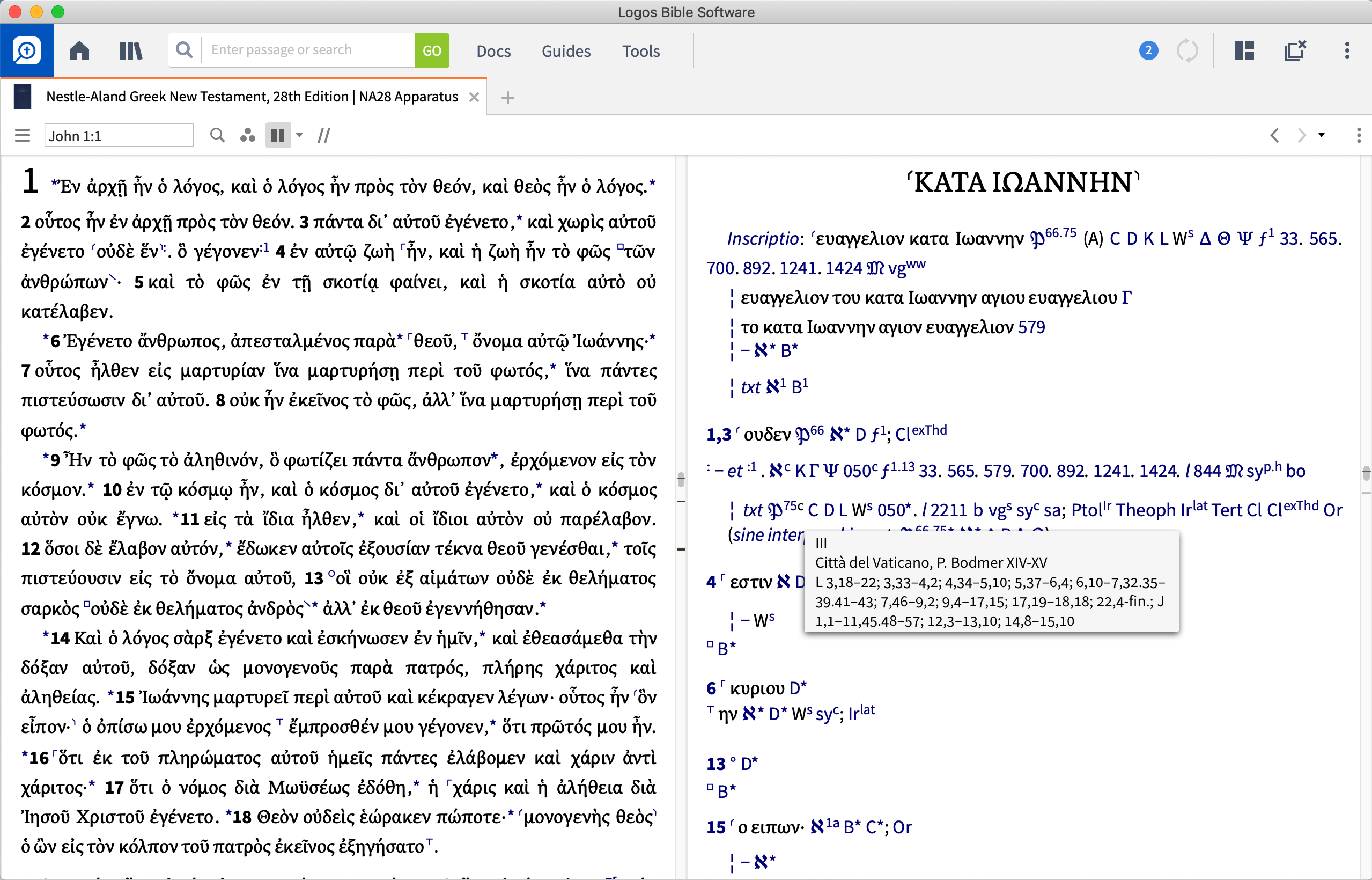Critical Apparatuses: What and Why
Logos Bible Software offers critical apparatuses for both the Greek and Hebrew Scriptures. Apparatuses are available in the following products:
- Stuttgart Electronic Study Bible (Greek and Hebrew)
- Novum Testamentum Graece Apparatum Criticum (Tischendorf) (Greek)
This page sets out to answer a few questions about critical apparatuses, how they're used, how they factor into biblical exegesis, and how they function as part of Logos Bible Software.
"What's an apparatus, and who would want one?"
1: People with interest in Bible translations.
Most modern Bible translations are based on the modern critical text(s) -- BHS (Hebrew) & NA/UBS (Greek). The NA/UBS text is an 'eclectic' manuscript. That is, it isn't a simple reproduction of a particularly good early manuscript that has been found. Rather, it is the product of work done to evaluate available manuscripts to construct what is thought to be the best reflection of the original canon/autographs.
In other words, textual critics have sifted through manuscripts (and manuscript fragments, citations within the writings of the fathers, lectionaries, and all sorts of very early translations [Syriac, Latin, etc.]) to obtain a better picture of which text was most likely the earliest and original. The Greek text itself is the product of that scholarship; the apparatus shows how and why the product ended up like it did.
Conversely, the BHS attempts to be a faithful representation of a single manuscript, Codex Leningradensis. Leningradensis is the oldest complete Hebrew bible, and generally of very high quality, but in those places where Leningradensis is defective, or most likely preserves a bad reading, the critical apparatus is essential for evaluating the other possible readings.

For any given verse, there are most likely alternate forms of words or even different words in a number of different manuscripts. The textual apparatus is the key that unlocks these differences. In the past, apparatuses have been reserved for trained scholars and textual critics due to their hugely abbreviated form and highly technical content. The "encoding" used to condense pages of information into minute footnotes also served as a deterrent to widespread use of the apparatus.
This is no longer the case. By publishing the apparatus electronically we have demystified its technical symbols and abbreviations. No longer forced to memorize arcane symbols, the user can now get directly to what's important: the data encoded in those symbols. By hovering the mouse over a symbol, its meaning is instantly displayed in a temporary pop-up window.
The bottom line is, people who have interest in Bible translations can see why different translations (i.e., NKJV and NASB) may render things differently. For example, the NKJV tends to prefer Byzantine readings, while the NASB uses the NA/UBS.
2: People with basic Greek training who have always wondered what all the stuff on the bottom of the printed page is all about.
Many students who have only been able to study Greek for one year or even one semester have a basic understanding of Greek, but have little understanding of the idea of variant readings, and how to use an apparatus. Such students also have little motivation to expend the effort to learn the intracacies of how to use the apparatus.
Here is one quick example that conveys how one may use the apparatus information: 2 Thess. 2:9 in NA27 has 'ἡ παρουσία'. Tischendorf notes that uncial 'F' omits the 'ἡ '. Important? Maybe, maybe not. But the point is, prior to having an apparatus (or having an excuse to figure out how to use one), you'd never have known that a manuscript omits that word. Knowing that it does, you can examine 'F' to see when it is dated, and even search to see where else 'F' offers variants or support for readings within I Thessalonians or other Pauline Epistles, or even the whole New Testament.
3: Translators and people who translate verses as part of their process of exegesis.

According to Gordon Fee, one of the major steps in the exegesis of a New Testament passage is to Establish the Text (Gordon Fee, New Testament Exegesis, Third Edition, p. 15). Fee continues:
The first concern of the interpreter of any ancient text is the textual one. What words did the author use, and in what order? The science that seeks to recover the original form of hand-produced documents is called textual criticism, which has become a very technical and complex field of study. With a small amount of concerted effort, however, student exegetes can learn enough so as (1) to feel at home with textual discussions (e.g., in articles and commentaries) and (2) to feel somewhat comfortable in making their own textual decisions.
All in all, the provision of a textual apparatus as comprehensive as that of Tischendorf provides the student of the Bible with another tool to examine the text of the New Testament in greater detail while enabling the student to practice a more complete exegesis of the New Testament text.
"What kinds of questions can an apparatus help answer?"
Here's a practical example with real consequences for translation today.
In 1 Tim 3:16, the "hymn" in the second half of the verse has the following line at the start:
Ὃς ἐφανερώθη ἐν σαρκί,
The focus here is the first word, Ὃς.
In uncial manuscripts, this would have looked like: OC (the 'C' is a lunate sigma, an archaic form, but used in uncials).
Early manuscripts tended to abbreviate significant words. This is why early manuscripts (e.g., Stephanus 1550) are full of abbreviations or use ligatures similar to the way miniscule script was written. One commonly known example: the "chirho" symbol is simply the greek letter chi (X) with the Greek letter rho (P) put on top of it. This represents the name "Christ" because it is the first two letters of "Christ" in Greek.
Similarly, "θεὸς" (Theos, as the name/title God) was commonly abbreviated by using the first and last letters of the word. Think of it as a NT-era application of the tetragrammaton. So, "θεὸς" would have been abbreviated "QC," with a line over the "QC" to indicate that it is an abbreviation, to alleviate confusion.
Uncial manuscripts dated prior to the eighth century are relatively unanimous in a non-θεὸς reading. There's Codex Bezae, which has Ὃ--but Bezae has a lot of readings that vary from other manuscripts. Even so, this seems to presuppose the better-testified reading, Ὃς. (Ὃς is masculine, Ὃ is neuter, but that's the only difference).
The manuscript that the QC (θεὸς) reading crept into ended up transmitting the reading along to the Textus Receptus. So, even though no uncials prior to 8th/9th century testify to this reading (apart from Bezae, they have the relative masculine pronoun, translated "Who" or "Whom" into English) it still made its way into the KJV text...and therefore into the NKJV text. NASB/ESV/NIV/NRSV all use the relative pronoun (whose antecedent interpreters typically read as "Christ", not "God").
The apparatus here does a few things:
- Points out that there is, in fact, a variant.
- Gives a history of significant textual witnesses on all sides, with information on the dates of the textual witnesses involved.
- Allows the reader to weigh this evidence and make a decision.
Some Logos users might know exactly what to do with this information; others may need an additional source to help make sense of it. This is where Metzger's A Textual Commentary on the Greek New Testament comes in.
Metzger's Textual Commentary helps the user boil this information down into practical application. The apparatus only tells you that there is a variant and what the options are--it relies on the knowledge of the reader to realize why this is a significant variant. Metzger explains, in common English, why this is significant. It is Metzger who goes into the abbreviation of θεὸς and how that was perhaps mis-copied (or intentionally edited by a 'helpful' copyist?) from the better-attested relative pronoun; and then how that got into the Textus Receptus.
To recap:
- NA27/Westcott-Hort (i.e., "Alexandrian"): Relative pronoun Ὃς
- TR/Byzantine Majority: Name of God, θεὸς
Therefore
- Texts using NA/UBS as base for NT: "Who" or "Whom," typically referring to Christ
- Texts using TR/Byz as base for NT: "God"
One final observation: Most technical commentaries and even some non-technical commentaries will mention this type of thing because it is significant. But having the apparatus (and Metzger's Textual Commentary) allows the user to dig for the information himself rather than relying on a commentary to present the data to him. The NA27 is systematic in the presentation of many of the more important witnesses. A commentary may pick and choose among the stuff the writer finds most interesting, or, perhaps, more germane to prove a particular point. Having access to the apparatus lets the user dig into this detail independently.
"How do I learn to weigh textual variants? What aids are available?"
For those fairly new to textual issues, Logos Bible Software offers two particularly helpful works that introduce the reader to some of the issues involved in using a textual apparatus and suggest approaches for thinking about textual variants.
One of the best places to start is with Wegner's A Student's Guide to Textual Criticism of the Bible and Patzia's The Making of the New Testament.
Bruce Metzger's A Textual Commentary on the Greek New Testament outlines the approach taken by the committe that assembled the United Bible Societies' Greek New Testament. The commentary covers only selected passages and variants, but a great deal can be learned through the discussions of how the committee arrived at their preferred readings.
Many seminary classes use Old Testament Exegesis & New Testament Exegesis by Douglas Stuart & Gordon Fee. Each of these titles contain a section on textual criticism. There is also a chapter on the role of textual criticism in biblical interpretation in A Handbook to the Exegesis of the New Testament by Stanley Porter.
There's also a great deal of information about text criticism (especially New Testament) on the Internet. A few sample links include:
- An Introduction to New Testament Textual Criticism (introductory)
- Interpreting Ancient Manuscripts (use the buttons at the top to navigate)
- TC: A Journal of Biblical Textual Criticism (fairly technical)